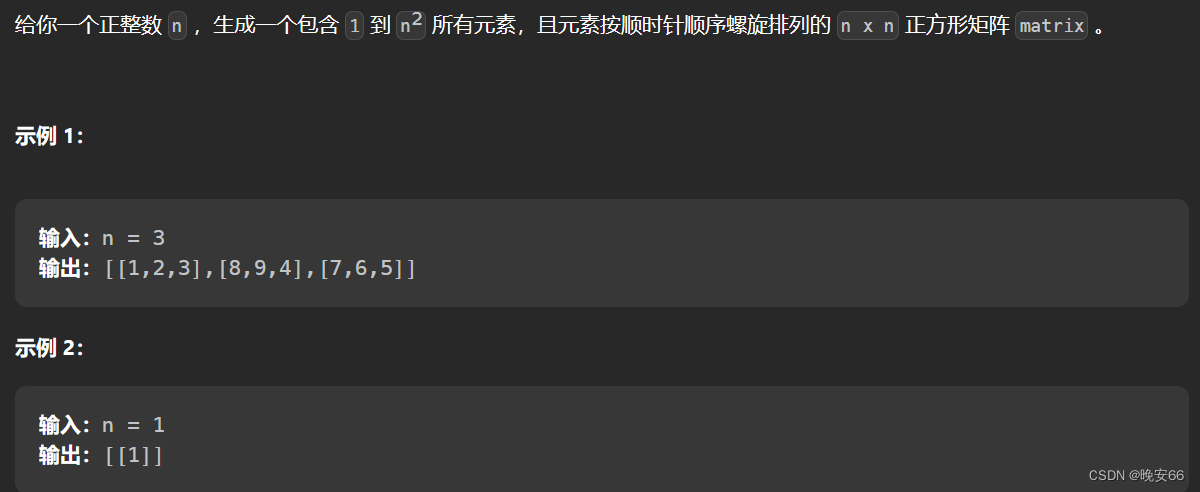所有的LeetCode题解索引,可以看这篇文章——【算法和数据结构】LeetCode题解。
题目

一、方向向量法
思路分析:螺旋矩阵在旋转过程中,我们选择的区间是左闭右开区间[ , ],例如方向为从左往右赋值时,从(0,0)赋值到(0,n-1),然后调转方向,赋值(1,n-1)到(n-1,n-1) 。简单示意图如下:

分析矩阵变换的增量delta_x和delta_y,这两个变量以右下左上的顺序变化时,其值依次为:{ {0,1},{1,0},{0,-1},{-1,0}}。那么我们发现delta_x = delta_y, delta_y = - delta_x。那么我们再引入一个临时变量用来交换。然后就是程序边界问题,程序当中使用if语句,res下一个
程序如下:
class Solution {
public:
// 方向向量法
vector<vector<int>> generateMatrix(int n) {
vector<vector<int>> res(n, vector<int>(n, 0)); // vector(n, ele)使用两次,就构造处一个嵌套vector矩阵
int delta_x = 0, delta_y = 1;
int x = 0, y = 0;
for (int i = 1; i <= n * n; i++) {
res[x][y] = i;
if (res[(x + delta_x + n) % n][(y + delta_y + n) % n] != 0) {
// 判断是否转弯,当dy为-1会造成 y+dy < 0,数组越界,加n是为了防止这个问题
int tmp = delta_y;
delta_y = -delta_x;
delta_x = tmp;
}
x += delta_x;
y += delta_y;
}
return res;
}
};
复杂度分析:
- 时间复杂度: O ( n 2 ) O(n^2) O(n2),遍历 n 2 n^2 n2遍。
- 空间复杂度: O ( 1 ) O(1) O(1)。
完整代码
# include<iostream>
# include <vector>
using namespace std;
class Solution {
public:
// 方向向量法
vector<vector<int>> generateMatrix(int n) {
vector<vector<int>> res(n, vector<int>(n, 0)); // vector(n, ele)使用两次,就构造处一个嵌套vector矩阵
int delta_x = 0, delta_y = 1;
int x = 0, y = 0;
for (int i = 1; i <= n * n; i++) {
res[x][y] = i;
if (res[(x + delta_x + n) % n][(y + delta_y + n) % n] != 0) {
// 判断是否转弯,当dy为-1会造成 y+dy < 0,数组越界,加n是为了防止这个问题
int tmp = delta_y;
delta_y = -delta_x;
delta_x = tmp;
}
x += delta_x;
y += delta_y;
}
return res;
}
};
void my_print(vector<vector<int>>nums, int n, string str) {
cout << str << endl;
for (vector<vector<int>>::iterator it = nums.begin(); it < nums.end(); it++) {
for (vector<int>::iterator vit = (*it).begin(); vit < (*it).end(); vit++) {
cout << *vit << ' ';
}
cout << endl;
}
cout << endl;
}
int main()
{
int n = 3;
Solution s1;
vector<vector<int>>matrix = s1.generateMatrix(n);
my_print(matrix, n, "生成的矩阵:");
system("pause");
return 0;
}
end